Performance Evaluation of Fee-Charging Policies to Reduce the Carbon Emissions of Urban Transportation in China
Abstract
1. Introduction
2. Materials and Methods
2.1. Study Area
2.2. Methodology
2.2.1. Methodological Framework
2.2.2. Calculation Model for Urban Transport Carbon Emissions
Calculation of CO2 Emissions
Calculation of CO2 Emissions Factors
2.2.3. DEA Model
2.3. Data Source and Descriptive Statistics
3. Results
3.1. Relationship between Fee-Charging Policies and Traffic Congestion
3.2. Annual Change in Transportation CO2 Emissions
3.3. Performance Evaluation of the Implementation
4. Discussion
4.1. Transportation CO2 Emissions Control Strategies
4.2. Policy Implications
5. Conclusions
Author Contributions
Funding
Institutional Review Board Statement
Informed Consent Statement
Data Availability Statement
Acknowledgments
Conflicts of Interest
References
- IPCC (Intergovernmental Panel on Climate Change). Summary for Policymakers: In Climate Change 2013: The Physical Science Basis. Contribution of Working Group I to the Fifth Assessment Report of the Intergovernmental Panel on Climate Change; Cambridge University Press: Cambridge, UK, 2013. [Google Scholar]
- Jones, R.S.; West, E. Environmental sustainability in veterinary anaesthesia. Vet. Anaesth. Analg. 2019, 46, 409–420. [Google Scholar] [CrossRef] [PubMed]
- Clark, P.U.; Shakun, J.D.; Marcott, S.A.; Mix, P.U.C.A.C.; Eby, M.; Kulp, S.; Levermann, A.; Milne, G.A.; Pfister, P.L.; Santer, B.D.; et al. Consequences of twenty-first-century policy for multi-millennial climate and sea-level change. Nat. Clim. Chang. 2016, 6, 360–369. [Google Scholar] [CrossRef]
- Wang, H.H.; Cao, R.X.; Zeng, W.H. Multi-agent based and system dynamics models integrated simulation of urban commuting relevant carbon dioxide emission reduction policy in China. J. Clean. Prod. 2020, 272, 1–19. [Google Scholar] [CrossRef]
- UNDESA. World Urbanization Prospects: The 2014 Revision; UNDESA: New York, NY, USA, 2014. [Google Scholar]
- IPCC. Climate Change 2014: Mitigation of Climate Change; Cambridge University Press: Cambridge, UK, 2015. [Google Scholar]
- Chow, A.S. Spatial-modal scenarios of greenhouse gas emissions from commuting in Hong Kong. J. Transp. Geogr. 2016, 54, 205–213. [Google Scholar] [CrossRef]
- EIA. International Energy Outlook; EIA: Washington, DC, USA, 2017. [Google Scholar]
- Yang, W.; Li, T.; Cao, X. Examining the impacts of socio-economic factors, urban form and transportation development on CO2 emissions from transportation in China: A panel data analysis of China’s provinces. Habitat. Int. 2015, 49, 212–220. [Google Scholar] [CrossRef]
- Yang, W.; Wang, W.; Ouyang, S. The influencing factors and spatial spillover effects of CO2 emissions from transportation in China. Sci. Total Environ. 2019, 696, 13390. [Google Scholar] [CrossRef]
- Zhao, Q.J.; Ding, S.; Wen, Z.M.; Toppinen, A. Energy flows and carbon footprint in the forestry-pulp and paper industry. Forests 2019, 10, 725. [Google Scholar] [CrossRef]
- An, S.; Hu, X.; Wang, J. Urban taxis and air pollution: A case study in Harbin, China. J. Transp. Geogr. 2011, 19, 960–967. [Google Scholar] [CrossRef]
- Cai, H.; Jia, X.; Chiu, A.S.F.; Hu, X.; Xu, M. Siting public electric vehicle charging stations in Beijing using big-data informed travel patterns of the taxi fleet. Transp. Res. Part D Transp. Environ. 2014, 33, 39–46. [Google Scholar] [CrossRef]
- Geng, Y.; Ma, Z.; Xue, B.; Ren, W.; Liu, Z.; Fujita, T. Co-benefit evaluation for urban public transportation sector e a case of Shenyang, China. J. Clean. Prod. 2013, 58, 82–91. [Google Scholar] [CrossRef]
- Luo, X.; Dong, L.; Dou, Y.; Zhang, N.; Ren, J.Z.; Li, Y.; Sun, L.; Yao, S.Y. Analysis on spatial-temporal features of taxis’ emissions from big data informed travel patterns: A case of Shanghai, China. J. Clean. Prod. 2017, 142, 926–935. [Google Scholar] [CrossRef]
- Wang, J.N.; Yang, J.T.; Lu, X.Y.; Wang, D.Q. Preliminary study on the system of environmental economic policies under market mechanism. China Environ. Sci. 1995, 15, 183–186. (In Chinese) [Google Scholar]
- Burchell, J.; Ison, S.; Enoch, M.; Budd, L. Implementation of the workplace parking levy as a transport policy instrument. J. Transp. Geogr. 2019, 80, 1–11. [Google Scholar] [CrossRef]
- Camporeale, R.; Caggiani, L.; Fonzone, A.; Ottomanelli, M. Study of the accessibility inequalities of cordon-based pricing strategies using a multimodal Theil index. Transport. Plan. Techn. 2019, 42, 498–514. [Google Scholar] [CrossRef]
- Gomez, J.; Vassallo, J.M. Has heavy vehicle tolling in Europe been effective in reducing road freight transport and promoting modal shift? Transportation 2020, 47, 865–892. [Google Scholar] [CrossRef]
- Santos, G. (Ed.) Road Pricing: Theory and Evidence (Vol. 9); University of Cambridge: Cambridge, UK, 2004. [Google Scholar]
- Maruyama, T.; Sumalee, A. Efficiency and equity comparison of cordon-and area-based road pricing schemes using a trip-chain equilibrium model. Transp. Res. Part A Policy Pract. 2007, 41, 655–671. [Google Scholar] [CrossRef]
- ITF (International Transport Forum). The Social Impacts of Road Pricing: Summary and Conclusions; ITF: Paris, France, 2018.
- Parmar, J.; Das, P.; Dave, S. Study on demand and characteristics of parking system in urban areas: A review. J. Traffic Transp. Eng. Engl. Ed. 2020, 7, 111–124. [Google Scholar] [CrossRef]
- Enoch, M.; Ison, S. Levying charges on private parking: Lessons from existing practice. World Transp. Policy Pract. 2005, 12, 5–14. [Google Scholar]
- Hamer, P.; Currie, G.; Young, W. Parking price policies–a review of the Melbourne congestion levy. In Proceedings of the Australasian Transport Research Forum 2011 Proceedings, Adelaide, Australia, 28–30 September 2011. [Google Scholar]
- Burchell, J.; Ison, S.G.; Enoch, M.E. The smeed report fifty years on: A role for the workplace parking levy? Transp. Plan. Technol. 2015, 38, 62–77. [Google Scholar] [CrossRef]
- Brand, C.; Preston, J.M. ‘60-20 emission’-The unequal distribution of greenhouse gas emissions from personal, non-business travel in the UK. Transp. Policy 2010, 17, 9–19. [Google Scholar] [CrossRef]
- Ma, J.; Chai, Y.W.; Liu, Z.L. The mechanism of CO2 emissions from urban transport based on individuals’ travel behavior in Beijing. Acta Geographica Sinica. 2011, 66, 1023–1032. (In Chinese) [Google Scholar]
- Cai, B.; Yang, W.; Cao, D.; Liu, L.; Zhou, Y.; Zhang, Z. Estimates of China’s national and regional transport sector CO2 emissions in 2007. Energ. Policy 2012, 41, 474–483. [Google Scholar] [CrossRef]
- Wang, W.W.; Zhang, M.; Zhou, M. Using LMDI method to analyze transport sector CO2 emissions in China. Energy 2011, 36, 5909–5915. [Google Scholar] [CrossRef]
- Alsabbagh, M.; Siu, Y.L.; Guehnemann, A.; Barrett, J. Integrated approach to the assessment of CO2 e-mitigation measures for the road passenger transport sector in Bahrain. Renew. Sustain. Energy Rev. 2017, 71, 203–215. [Google Scholar] [CrossRef]
- Hasan, M.A.; Chapman, R.; Frame, D.J. Acceptability of transport emissions reduction policies: A multi-criteria analysis. Renew. Sustain. Energy Rev. 2020, 133, 110298. [Google Scholar] [CrossRef]
- Sueyoshi, T.; Yuan, Y.; Goto, M. A literature study for DEA applied to energy and environment. Energy Econ. 2016, 62, 104–124. [Google Scholar] [CrossRef]
- Song, M.L.; Wang, S.H.; Lei, L.; Zhou, L. Environmental efficiency and policy change in China: A new meta-frontier non-radial angle efficiency evaluation approach. Process Saf. Environ. Protect. 2019, 121, 281–289. [Google Scholar] [CrossRef]
- Guo, J.; Zhao, M.; Wu, X.; Shi, B.; Gonzalez, E.D.R.S. Study on the distribution of PM emission rights in various provinces of China based on a new efficiency and equity two-objective DEA model. Ecol. Econ. 2021, 183, 106956. [Google Scholar] [CrossRef]
- Charnes, A.; Cooper, W.W.; Rhodes, E. Measuring the efficiency of decision making units. Eur. J. Oper. Res. 1978, 2, 429–444. [Google Scholar] [CrossRef]
- EI Mehdi, R.; Hafner, C.M. Local government efficiency: The case of moroccan municipalities. Afr. Dev. Rev. 2014, 26, 88–101. [Google Scholar] [CrossRef]
- Rotoli, F.; Valeri, E.; Ricci, S.; Rizzetto, L.; Malavasi, G. An analysis of the railway access charges regime in the Italian context. Transp. Policy 2018, 64, 20–28. [Google Scholar] [CrossRef]
- Liu, Z.; Guan, D.B.; Crawford-Brown, D.; Zhang, Q.; He, K.; Liu, J.G. A low carbon road map for China. Nature 2013, 500, 143–145. [Google Scholar] [CrossRef]
- Liu, X.; Wu, J. Energy and Environmental Efficiency analysis of China’s regional transportation sectors: A slack-based DEA approach. Energy Syst. 2015, 8, 747–759. [Google Scholar] [CrossRef]
- Zhang, J.R.; Zeng, W.H.; Shi, H. Regional environmental efficiency in China: Analysis based on a regional slack-based measure with environmental undesirable outputs. Ecol. Indic. 2016, 71, 218–228. [Google Scholar] [CrossRef]
- Sun, J.S.; Yuan, Y.; Yang, R.; Ji, X.; Wu, J. Performance evaluation of Chinese port enterprises under significant environmental concerns: An extended DEA-based analysis. Transp. Policy 2017, 60, 75–86. [Google Scholar] [CrossRef]
- Chen, L.; Wu, F.M.; Wang, Y.M.; Li, M.J. Analysis of the environmental efficiency in China based on the DEA cross-efficiency approach under different policy objectives. Expert Syst. 2020, 37, 1–18. [Google Scholar] [CrossRef]
- Dong, C.; Huang, G.H.; Cai, Y.P.; Liu, Y. An inexact optimization modeling approach for supporting energy systems planning and air pollution mitigation in Beijing city. Energy 2012, 37, 673–688. [Google Scholar] [CrossRef]
- NBS (National Bureau of Statistics). China Statistical Yearbook; China Statistics Press: Beijing, China, 2019.
- BMBS (Beijing Municipal Bureau of Statistics). Beijing Statistical Yearbook; Beijing Municipal Bureau of Statistics: Beijing, China, 2006–2019. Available online: http://nj.tjj.beijing.gov.cn/nj/main/2019-tjnj/zk/indexch.htm (accessed on 13 September 2019).
- IPCC (Intergovernmental Panel on Climate Change). IPCC Guidelines for National Greenhouse Gas Inventories; IPCC: Geneva, Switzerland, 2006. [Google Scholar]
- Wang, H.; Zeng, W. Revealing Urban carbon dioxide (CO2) emission characteristics and influencing mechanisms from the perspective of commuting. Sustainability 2019, 11, 385. [Google Scholar] [CrossRef]
- Zhang, J.; Wang, J.; Zeng, W.; Jiang, H.; Yang, F. Performance evaluation on the water pollution control charging policy of Dianchi Lake basin. China Environ. Sci. 2016, 35, 634–640. (In Chinese) [Google Scholar]
- Liu, W.; Tian, J.; Li, X.; Liu, T.; Chen, L. Studies on environmental performance of sector-integrate eco-Industrial parks with data envelopment analysis. Ecol. Econ. 2012, 7, 125–128. (In Chinese) [Google Scholar]
- Wu, L.; Yi, R.; Ma, Z. Evaluation on the efficiency of the urban infrastructural investment in Inner Mongolia based on the method of DEA. J. Inn. Mong. Univ. Philos. Soc. Sci. 2012, 44, 5–9. (In Chinese) [Google Scholar]
- IEA. Key World Energy Statistics; IEA: Paris, France, 2016. [Google Scholar]
- Preeti, A.; Suresh, J. Energy demand and CO2 emissions from urban on-road transport in Delhi: Current and future projections under various policy measures. J. Clean. Prod. 2016, 128, 48–61. [Google Scholar] [CrossRef]
- Proost, S.; Dender, K.V. Energy and environment challenges in the transport sector. Econ. Transp. 2012, 1, 77–87. [Google Scholar] [CrossRef]
- Doll, C.N.H.; Balaban, O. A methodology for evaluating environmental cobenefits in the transport sector: Application to the Delhi metro. J. Clean. Prod. 2013, 58, 61–73. [Google Scholar] [CrossRef]
- Kay, A.I.; Noland, R.B.; Rodier, C.J. Achieving reductions in greenhouse gases in the US road transportation sector. Energy Policy 2014, 69, 536–545. [Google Scholar] [CrossRef]
- İrfan, B.; Islam, S.B.; Muammer, K. Impact assessment of supply-side and demand-side policies on energy consumption and CO2 emissions from urban passenger transportation: The case of Istanbu. J. Clean. Prod. 2019, 219, 391–410. [Google Scholar] [CrossRef]
- Tian, Y.P.; Song, W.J.; Liu, M. An assessment of how environmental policy affects urban innovation: Evidence from China’s low-carbon pilot cities program. Econ. Anal. Policy 2021, 71, 41–56. [Google Scholar] [CrossRef]
- Wang, Z.; Xiao, Z.; Tam, C.Y.; Pan, W.J.; Chen, J.; Hu, C.; Ren, C.; Wei, W.; Yang, S. The projected effects of urbanization and climate change on summer thermal environment in Guangdong-Hong Kong-Macao Greater Bay Area of China. Urban Clim. 2021, 37, 100866. [Google Scholar] [CrossRef]
- Progiou, A.G.; Ziomas, I.C. Road traffic emissions impact on air quality of the Greater Athens Area based on a 20 year emissions inventory. Sci. Total Environ. 2011, 410, 1–7. [Google Scholar] [CrossRef]
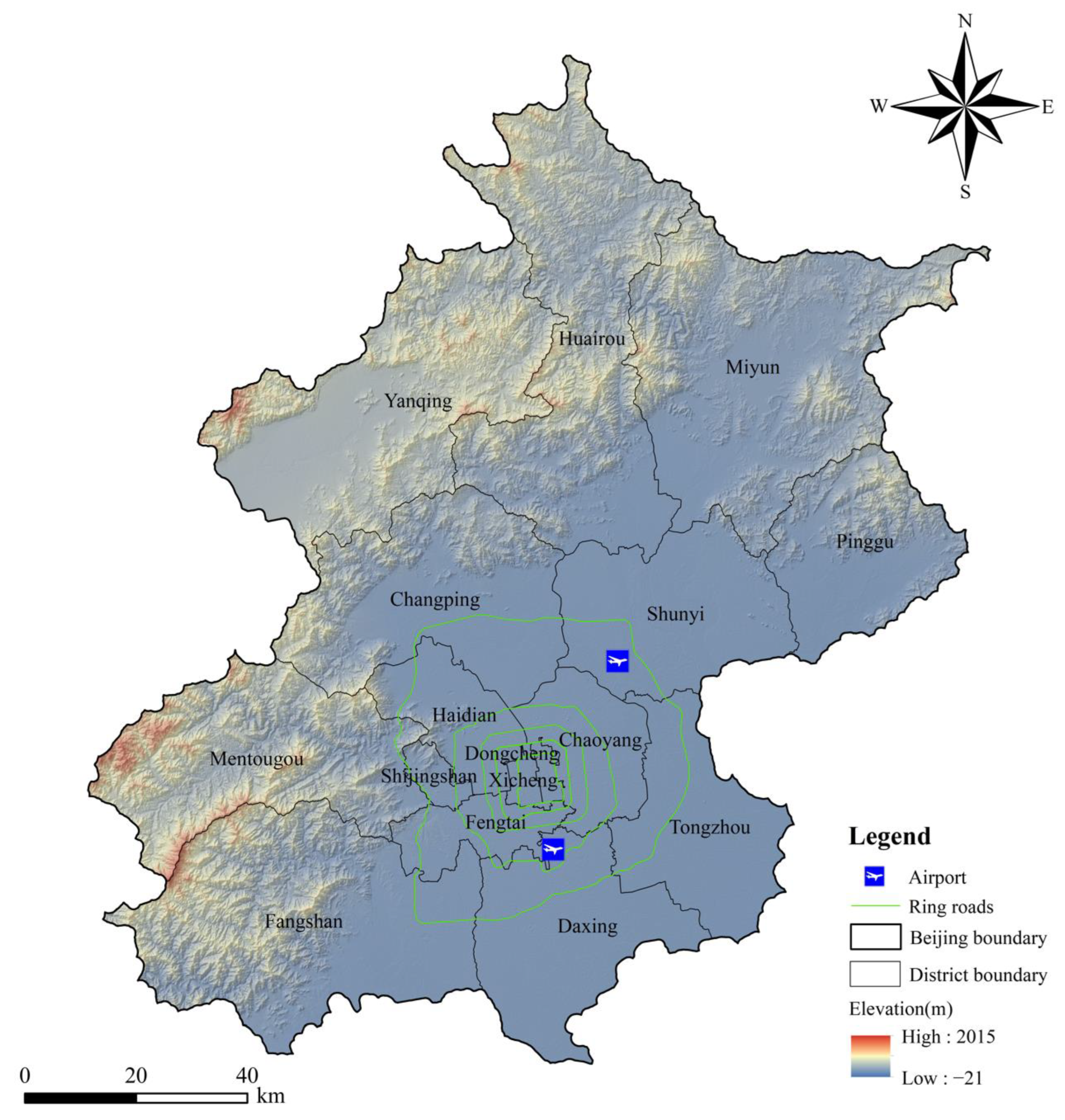
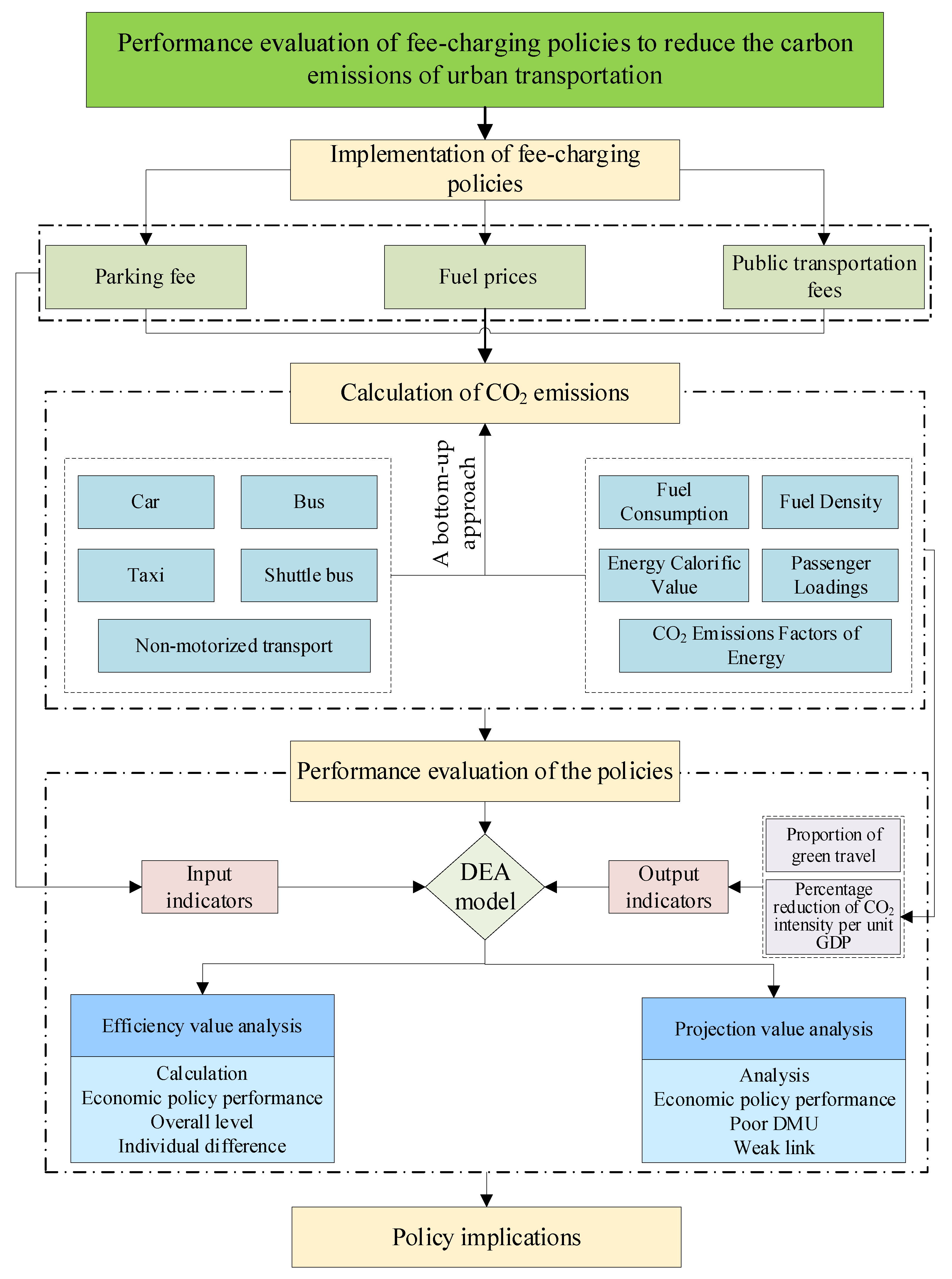
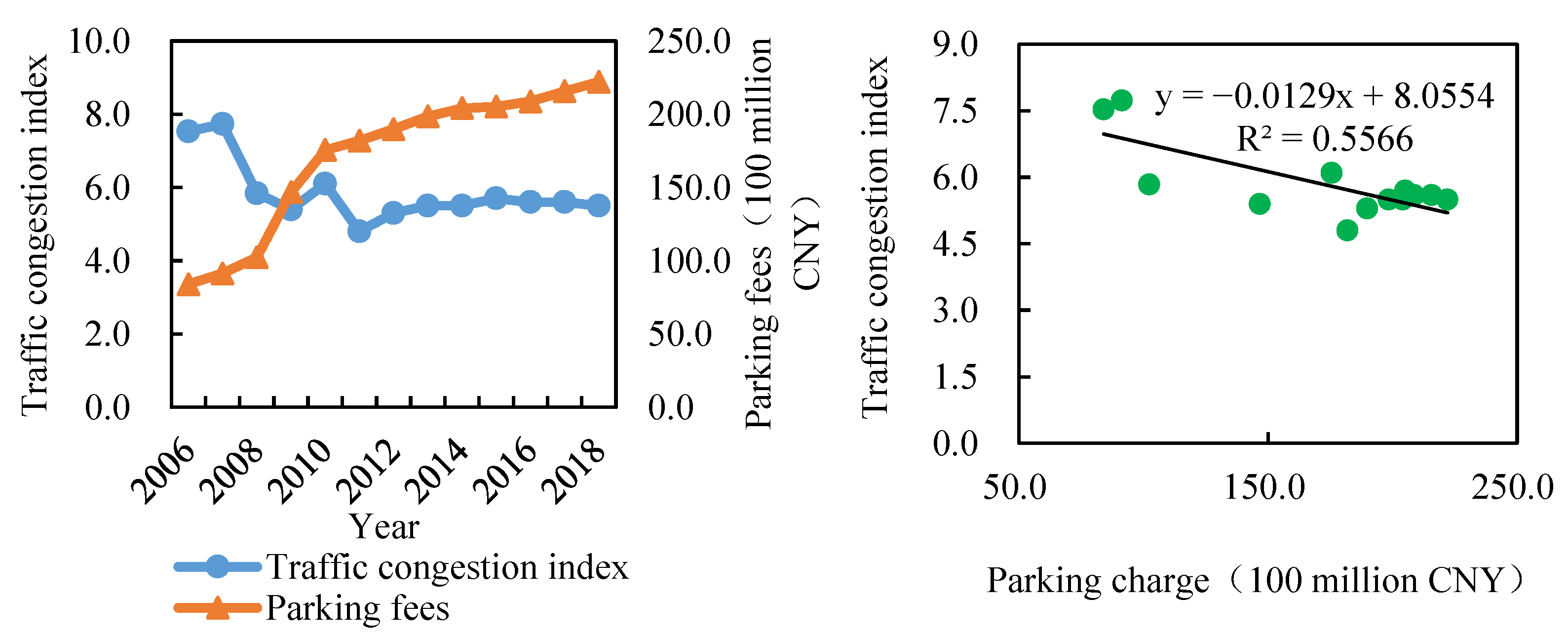
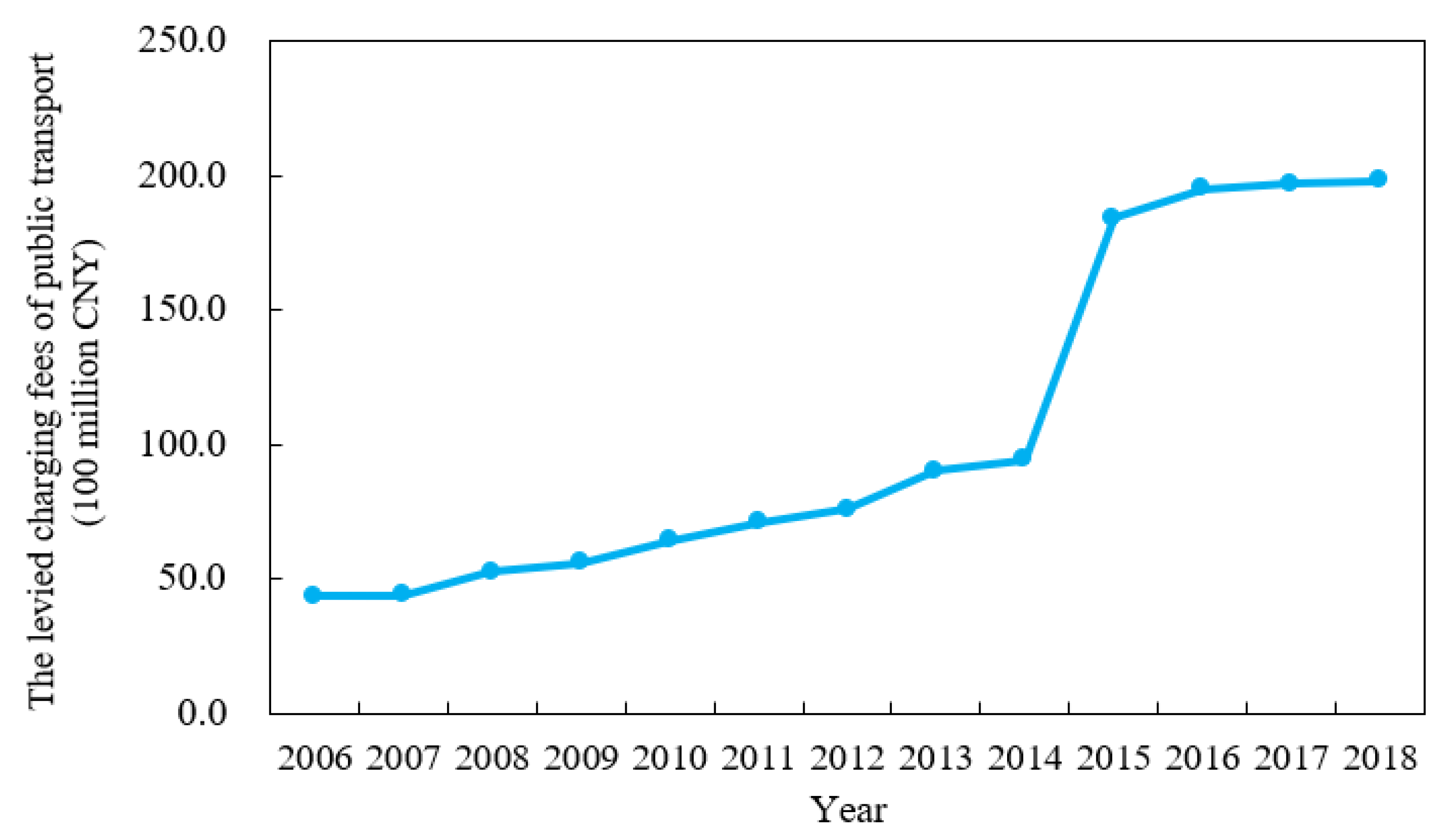
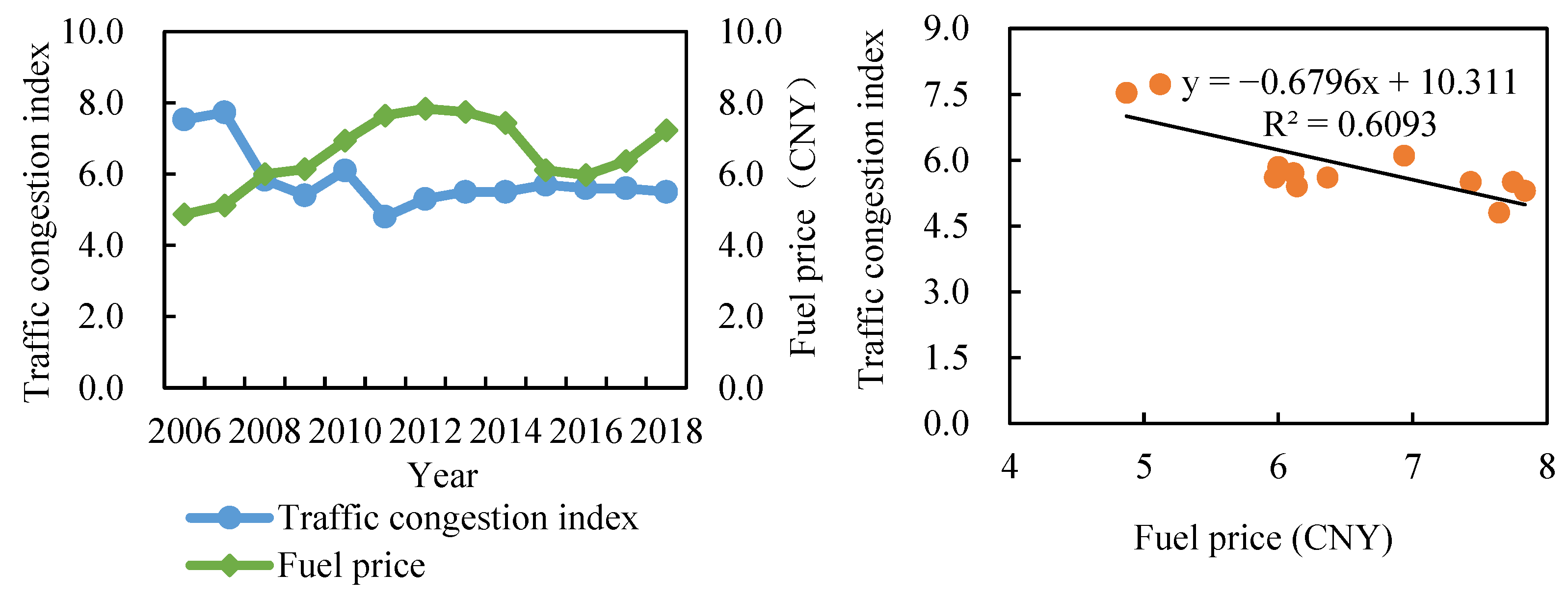

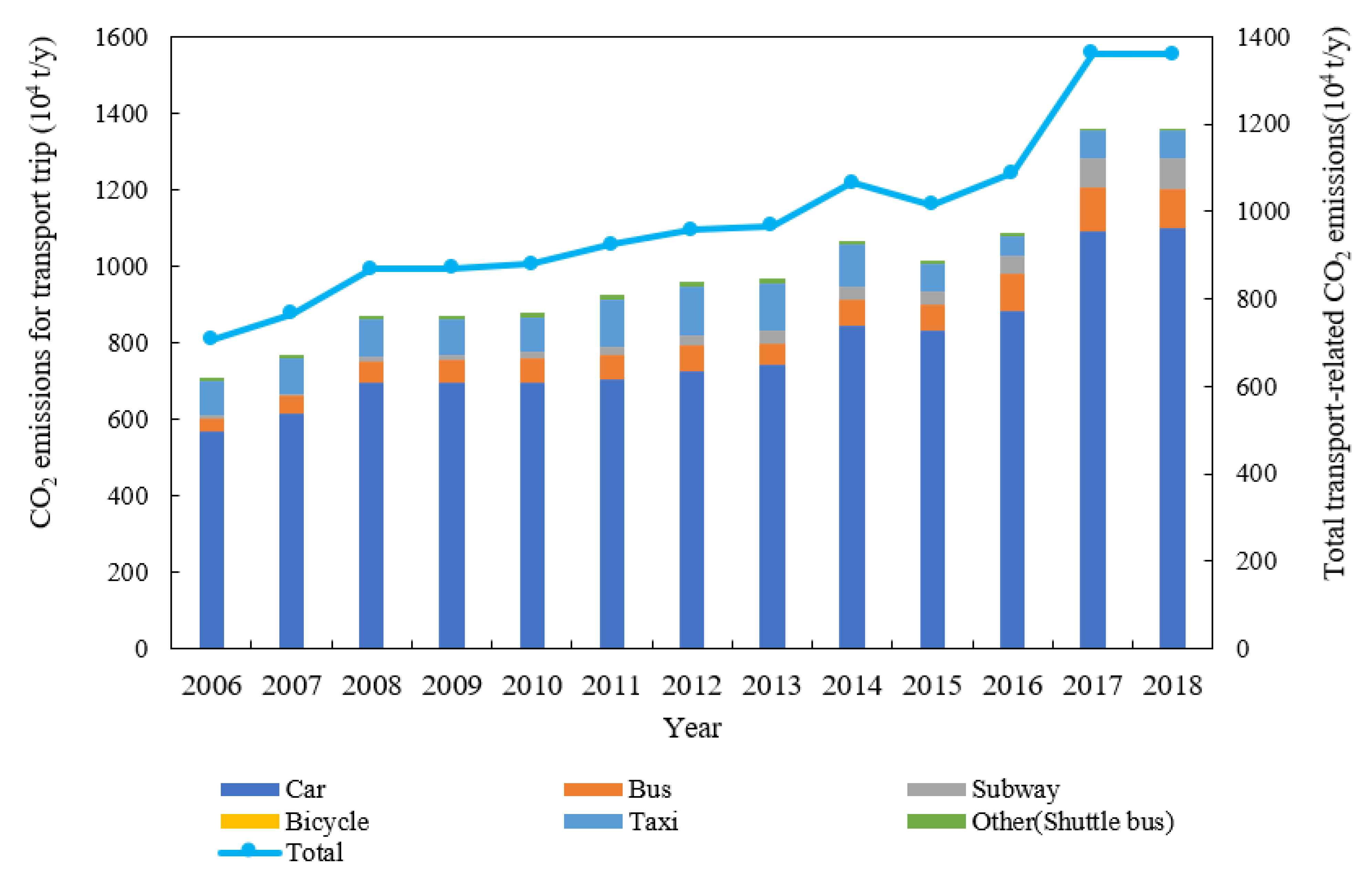
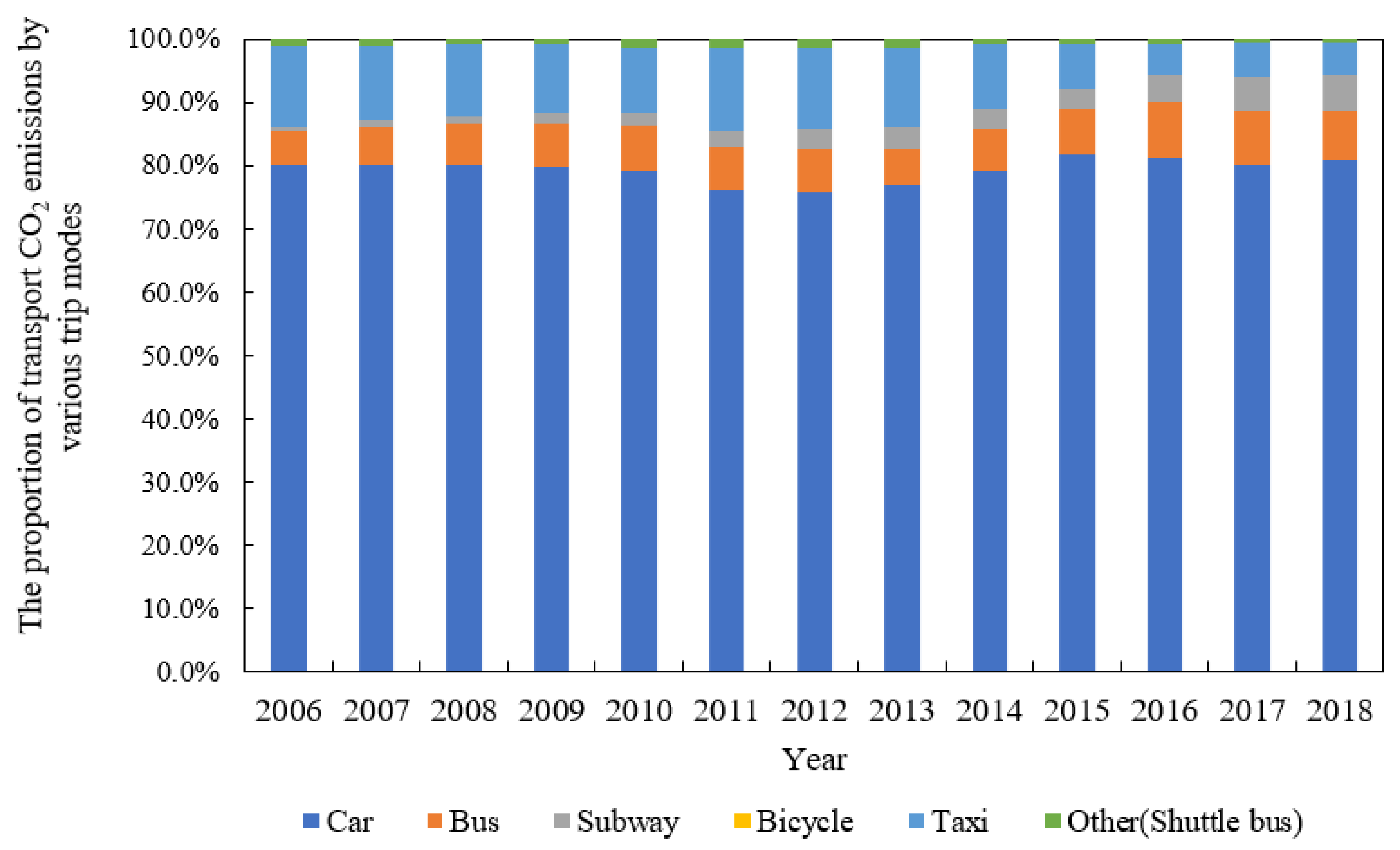
| Travel Mode | Fuel Consumption per km/L·km−1 | Fuel Density/kg·L−1 | Energy Calorific Value/TJ·kg−1 | CO2 Emissions Factors of Energy/kg·TJ−1 | Passenger Loadings | CO2 Emission Factor/kg. (People·km)−1 |
|---|---|---|---|---|---|---|
| Car | 0.088 | 0.725 | 0.0000443 | 69,300 | 1.1 | 0.1781 |
| Bus | 0.4 | 0.835 | 0.000043 | 74,100 | 50 | 0.0213 |
| Subway | 1.27 | / | 0.0000258 | 94,600 | 340 | 0.0091 |
| Taxi | 0.088 | 0.725 | 0.0000443 | 69,300 | 1.1 | 0.1781 |
| Shuttle bus | 0.4 | 0.835 | 0.000043 | 74,100 | 40 | 0.0266 |
| Non-motorized transport | 0 | 0 | 0 | 0 | 1 | 0 |
| Area | Maximum Parking Charge | Parking Fees Standard | ||||||
|---|---|---|---|---|---|---|---|---|
| Day | Night | |||||||
| On the Road | Off the Road | Open Air | Non-Open Air | |||||
| Within the First Hour (CNY/15 min) | After the First Hour (CNY/15 min) | Open Air (CNY/15 min) | Non-Open Air (CNY/15 min) | CNY/2 h | CNY/2 h | |||
| Non-residential area | Temporary parking in public parking lot | Category I region | 2.5 | 3.75 | 2 | 1.5 | 1 | 2.5 |
| Category II region | 1.5 | 2.25 | 1.25 | 1.25 | ||||
| Category III region | 0.5 | 0.75 | 0.5 | 0.5 | ||||
| Long-term parking in open-air public parking lot | No more than CNY 150/month, CNY 1600/year | |||||||
| Long-term parking in public buildings | Market adjust price | |||||||
| Park and ride (P + R) park | CNY 2/time | |||||||
| Independent parking garage | Market price | |||||||
| Residential area | Temporary parking in open parking lot | CNY 1/two h | ||||||
| Long-term parking in open parking lot | No more than CNY 150/month, CNY 1600/year | |||||||
| Temporary parking of underground parking garage | No more than CNY 1/half an hour | |||||||
| Underground parking garage, parking building, and three-dimensional parking facilities shall be built for long-term parking | Market price | |||||||
| Indicator Type | Index Name (unit) | Total Sample | Minimum Value | Maximum Value | Average Value | Standard Deviation | Coefficient of Variation | Skewness |
|---|---|---|---|---|---|---|---|---|
| Input indicators | Public transportation fees (CNY 100 million) | 13 | 43.67 | 197.99 | 104.99 | 63.31 | 0.60 | 0.75 |
| Annual parking fee collection (CNY 100 million) | 13 | 83.98 | 222.07 | 171.20 | 48.95 | 0.29 | −0.96 | |
| Annual collection of fuel fees (CNY 100 million) | 13 | 332.83 | 1573.36 | 1042.56 | 417.62 | 0.40 | −0.65 | |
| Output indicators | Proportion of green travel (%) | 13 | 68.40 | 73.00 | 70.34 | 1.33 | 0.02 | 0.41 |
| Percentage reduction in carbon emission intensity per unit GDP (%) | 13 | 1.30 | 50.71 | 31.76 | 17.19 | 0.54 | −0.64 |
| DMUs | Input Slack (CNY 100 million) | Output Slack (%) | Efficiency Value | ∑λ*j | Returns to Scale | |||||
|---|---|---|---|---|---|---|---|---|---|---|
| S1−* | S2−* | S3−* | S1+* | S2+* | TE | PTE | SE | |||
| 2006 | 0 | 0 | 0 | 0 | 0 | 1.000 | 1.000 | 1.000 | 1.000 | CRS |
| 2007 | 0 | 0 | 0 | 0 | 0 | 1.000 | 1.000 | 1.000 | 1.000 | CRS |
| 2008 | 2.995 | 0 | 109.639 | 0 | 0 | 0.878 | 0.976 | 0.900 | 1.122 | DRS |
| 2009 | 0 | 18.891 | 5.186 | 0 | 0 | 0.919 | 0.975 | 0.942 | 1.069 | DRS |
| 2010 | 0 | 16.482 | 0 | 0 | 0 | 0.989 | 0.992 | 0.996 | 0.993 | IRS |
| 2011 | 0 | 0 | 0 | 0 | 0 | 1.000 | 1.000 | 1.000 | 1.000 | CRS |
| 2012 | 0 | 0 | 0 | 0 | 0 | 1.000 | 1.000 | 1.000 | 1.000 | CRS |
| 2013 | 0 | 0 | 0 | 0 | 0 | 1.000 | 1.000 | 1.000 | 1.000 | CRS |
| 2014 | 0 | 0 | 14.164 | 0 | 0 | 0.957 | 1.000 | 0.957 | 1.063 | DRS |
| 2015 | 0 | 0 | 0 | 0 | 0 | 1.000 | 1.000 | 1.000 | 1.000 | CRS |
| 2016 | 7.480 | 0 | 15.585 | 0.478 | 0 | 0.994 | 1.000 | 0.994 | 1.017 | DRS |
| 2017 | 11.336 | 0 | 179.093 | 0 | 0 | 0.871 | 0.994 | 0.877 | 1.173 | DRS |
| 2018 | 2.712 | 0 | 283.323 | 0 | 0 | 0.904 | 1.000 | 0.904 | 1.144 | DRS |
| Average | 0.962 | 0.999 | 0.894 | |||||||
| DMUs | Adjusted Value of Input Index (CNY 100 Million) | Adjusted Value of Output Index (%) | |||
|---|---|---|---|---|---|
| Public Transport Charges | Annual Parking Fee | Annual Collection of Fuel Fee | Proportion of Green Travel | Percentage Reduction in Carbon Emission Intensity per Unit GDP | |
| 2008 | 49.337 | 102.317 | 443.376 | 78.584 | 10.364 |
| 2009 | 55.954 | 127.803 | 672.864 | 74.671 | 18.211 |
| 2010 | 64.179 | 159.047 | 959.287 | 69.179 | 27.874 |
| 2014 | 94.134 | 204.072 | 1391.821 | 74.297 | 43.784 |
| 2016 | 187.427 | 208.671 | 1226.706 | 71.933 | 51.035 |
| 2017 | 185.375 | 215.679 | 1237.119 | 82.792 | 49.917 |
| 2018 | 195.280 | 222.066 | 1290.041 | 80.778 | 52.893 |
Publisher’s Note: MDPI stays neutral with regard to jurisdictional claims in published maps and institutional affiliations. |
© 2022 by the authors. Licensee MDPI, Basel, Switzerland. This article is an open access article distributed under the terms and conditions of the Creative Commons Attribution (CC BY) license (https://creativecommons.org/licenses/by/4.0/).
Share and Cite
Wang, H.; Shi, W.; Xue, H.; He, W.; Liu, Y. Performance Evaluation of Fee-Charging Policies to Reduce the Carbon Emissions of Urban Transportation in China. Atmosphere 2022, 13, 2095. https://doi.org/10.3390/atmos13122095
Wang H, Shi W, Xue H, He W, Liu Y. Performance Evaluation of Fee-Charging Policies to Reduce the Carbon Emissions of Urban Transportation in China. Atmosphere. 2022; 13(12):2095. https://doi.org/10.3390/atmos13122095
Chicago/Turabian StyleWang, Huihui, Wanyang Shi, Hanyu Xue, Wanlin He, and Yuanyuan Liu. 2022. "Performance Evaluation of Fee-Charging Policies to Reduce the Carbon Emissions of Urban Transportation in China" Atmosphere 13, no. 12: 2095. https://doi.org/10.3390/atmos13122095
APA StyleWang, H., Shi, W., Xue, H., He, W., & Liu, Y. (2022). Performance Evaluation of Fee-Charging Policies to Reduce the Carbon Emissions of Urban Transportation in China. Atmosphere, 13(12), 2095. https://doi.org/10.3390/atmos13122095








